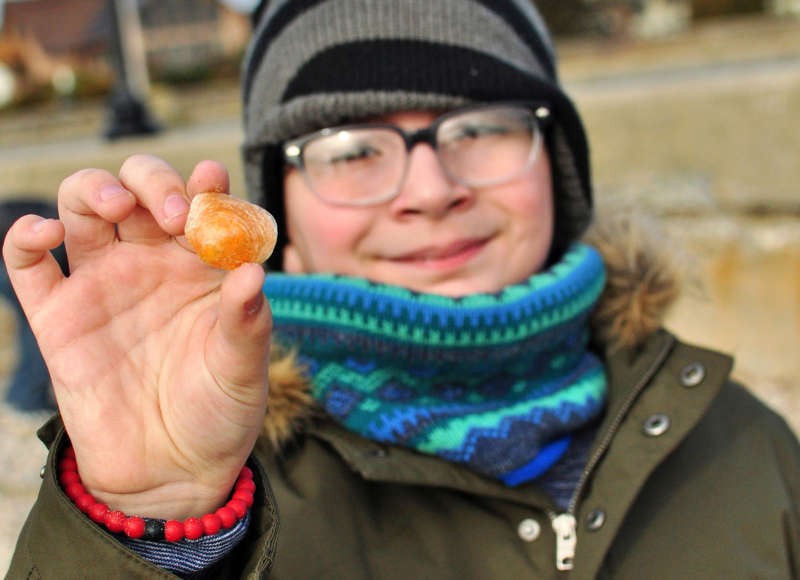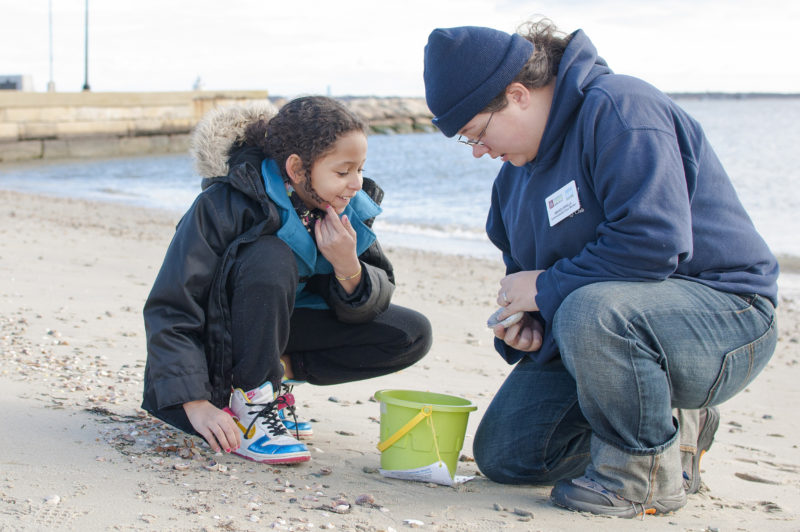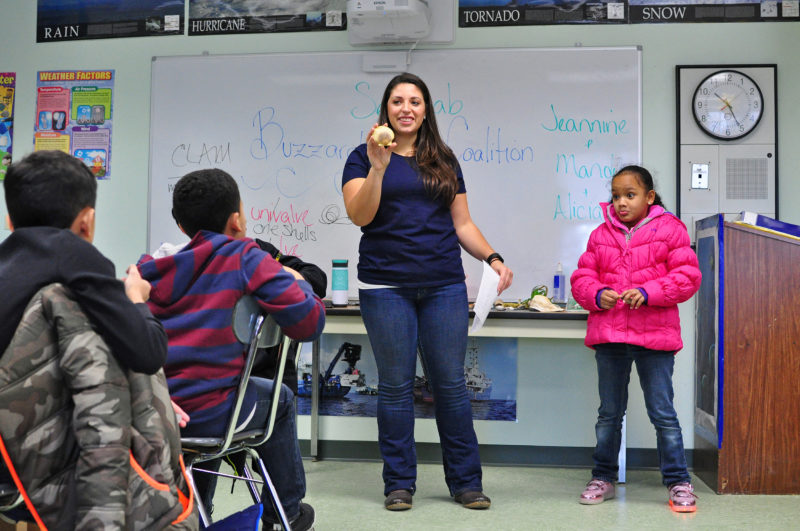Sea Lab beach walks give New Bedford students a view of Buzzards Bay life
To some, taking a walk on the beach in the middle of winter might not sound like fun. But for fourth-graders in New Bedford Public Schools, beach walks with the Coalition as part of the city’s Sea Lab program – no matter what time of year – are opening a new window to learning, exploration, and imagination on Buzzards Bay.

During beach walks with the Coalition at Sea Lab, students discover the various types of shells that wash up on East Beach and learn what type of animal they are.
A chilly coastal breeze blew off Buzzards Bay one recent morning as 20 children from New Bedford’s Hathaway School combed the sand at East Beach looking for rocks, shells, and other unique creatures that had washed ashore in the winter waves.
“Look!” yelled one boy, holding out his hand as he ran toward his friends. Nestled in his palm was a clear, gelatinous mass: a comb jelly, dotted with big grains of sand.
“Is that alive?” asked Jeannine Louro, a Commonwealth Corps Environmental Educator serving with the Coalition. When the students responded with a chorus of “yes”es, they knew what to do without being asked: return the comb jelly back to its home at the edge of the rolling tide.
For the past five years, the Coalition has been leading these weekly beach walks as part of Sea Lab, a marine science studies program funded through the New Bedford Public Schools. Over the course of each year, Coalition environmental educators guide every fourth-grade class in New Bedford – more than 1,200 students in all – on a walk on this beach as part of Sea Lab.
Some students also take a second Sea Lab-sponsored trip with the Coalition to The Sawmill in Acushnet, where they learn about aquatic life along the Acushnet River – where the waters of outer New Bedford Harbor begin their downstream journey toward Buzzards Bay.
“It takes a community to educate, so we decided to bring that community into the classroom,” said Simone Bourgeois, facilitator of the Sea Lab program. As part of this community spirit, Sea Lab and the Coalition struck up a partnership in 2012 to bring as many students as possible to the shores of Buzzards Bay. “We’re very grateful for the partnership because our children have an experience they may not be able to have otherwise.”

Coalition environmental educator Mandy Bonilla points out a colorful quahog shell that a student found on East Beach during her beach walk at Sea Lab.
Each Friday morning, a bus pulls up to the Sea Lab building in the South End of New Bedford, located steps away from East Beach. In the science classroom, students learn how to point out Buzzards Bay on a map; together, they break down the meaning of two new words: univalves (animals with one shell) and bivalves (animals with two shells). By incorporating these English and social studies lessons, Sea Lab takes environmental education beyond just science.
To reinforce these classroom lessons on the beach, Coalition educators ask the same question each time students pick up a new shell up from the sand: “Is that one shell or two?”
On this January morning, a stack of slipper shells stuck to an empty quahog shell stumped a few students, who came to Louro to show her their find. Eventually, one student yelled out the right answer: “One!”
Louro challenged them to think creatively about life for the marine animals in this beach environment. “If they only have one shell, how do they protect themselves?” she asked.
But the students quickly figured it out. “They stack on top of each other!”

Back in the classroom, Coalition environmental educator Jeannine Louro has students show off the shells they found. Together, the class decides whether each shell is a univalve (an animal with one shell) or a bivalve (an animal with two shells).
Before the students leave the classroom each week, Coalition educators always ask the students whether they’ve ever been to the beach in New Bedford. Despite the fact that they all live in the city, not every hand goes up.
“There are so many children who have never been to East Beach and experienced the marine environment,” said Bourgeois of the students who pass through Sea Lab during the academic year. “They may not realize they live on the Atlantic Ocean.”
When the bus rolls away from Sea Lab around noon, each student carries home with them a small shell as a token of their trip to the beach. But they’re also bringing back something much more important: the experience and memory of their visit to the shores of Buzzards Bay.
“When you see the smiles and the aha! moments, you know they’re having an experience they will never forget,” said Bourgeois.